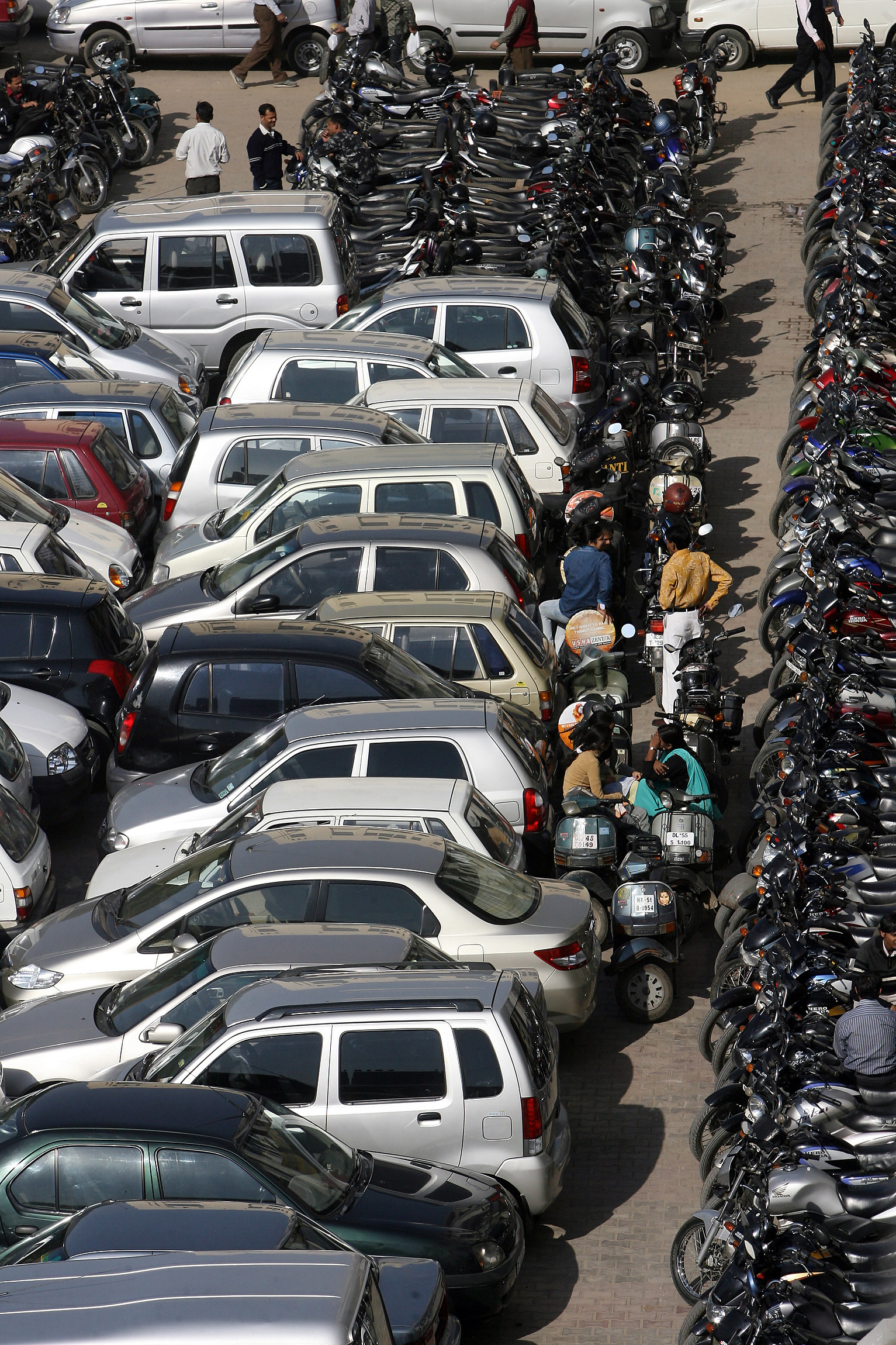Over one crore vehicles are parked in Delhi at any time. How can the city possibly find room for all of them? Efforts are being made but they can’t keep pace with the increasing vehicle population
The chairman of Environmental Pollution – Prevention and Control Authority (EPCA), Dr Bhure Lal, recently was caught in a fix. Lal had gone to meet his friend at a posh South Delhi colony where he decided to park his car at his friend’s home for the night. What happened the next morning when Lal had to move his car out, was amusing but appalling at the same time.
“My friend had to wake up people from four houses to set aside their cars so that my car could move. You can’t possibly take a U-turn in any of the lanes,” Lal recounts.
While Lal managed to get his situation resolved amicably, a report submitted by EPCA to the Supreme Court notes that parking has become a serious law and order issue in New Delhi. Delhiites should be extremely worried because neighbourhood brawls over parking have become common. A whopping 250 calls are made to Delhi Police every day, only concerning fights related to parking. And there is at least one death per month due to parking scuffle.
The latest economic survey of February 2019 states that Delhi has a vehicle population of 109.86 lakhs, which is much more than most of the cities’ vehicle population combined.
While close to 7.5 lakh vehicles are registered on a daily basis in Delhi, the space available for these vehicles remains the same as a city does not expand geographically.
Delhi government decided to find a solution to the parking menace by constituting a special panel of experts in 2017. The parking policy as formulated by this panel stated: “Parking only in demarcated areas on public spaces and open surfaces in residential areas against parking charges to be decided by civic agencies on the basis of Base Parking Charge. This civic agency will consult RWAs before deciding the charge.’’
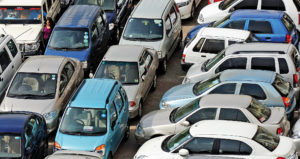
The policy paper also mentioned that management and charge for residential parking must be designed to prevent parking spill over from neighbouring commercial areas. However, these policies didn’t go well with the Delhi Government. Transport Minister Kailash Gahlot called off the policy on February 1, saying that cars are not provided any security even after paying the parking fee. The National Capital Territory of Delhi (NGCT) filed an affidavit seeking time to notify the finalised and approved Parking Rules 2017. The Supreme Court directed EPCA to review the proposed modifications and to submit a report.
Prem Shankar Jha, Deputy Commissioner of SDMC is visibly miffed by Gahlot’s move to not fine the disruptors. “If you are not charging a particular segment of the society, you are burdening others, which is unfair in so many ways. You are encroaching my space to walk and move, which is a basic right,” Jha said.
The Transport Department of the Government of National Capital Territory of Delhi filed a petition on February 7, 2019 with the Supreme Court for certain amendments in the policy. The officers in MCD indicate in hushed tones that the government fears losing their vote banks and hence, is aiming for amendments.
The Supreme Court was initially against the clause of charging residential vehicles, but has now sought EPCA’s (Environment and Pollution (Prevention and Control) Authority) involvement in the case.
EPCA’s report to SC further states that vehicles remain parked for 95 per cent of their lifetime. Eighty-five per cent of the parking spaces are occupied by personal vehicles and buses take up barely 4 to 5 per cent of the total equivalent car space. This takes away the precious urban land from other essential services in cities.
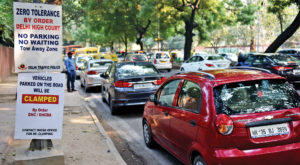
De-congested Markets
Jha who is one of the architects of the now shelved policy has successfully transformed markets — like Karol Bagh and Lajpat Nagar — from extremely congested areas to being pedestrian friendly. “Regulating markets is still possible as there is some idea of the number of vehicles that arrive and the preparations that need to be made for them to be parked. On the other hand, regulation of the residential vehicles needs more elaborate management,” he said.
One thing that MCD did to decongest these markets was to involve the market associations in the process. “This was fixed by UTTIPEC (Unified Traffic and Transportation Infrastructure Planning and Engineering Centre) when Delhi was hosting the Commonwealth Games in 2010. It was decided that markets had to be made traffic-free.
“The then commissioner Varsha Joshi was very co-operative. She called us and took the initiative of providing alternative parking space. We agreed. But the rate that they were quoting to us was very high. The amount was about six lakh rupees per month. Then we negotiated and the contract was given to us for three lakhs,” Murali Mani, President of Market Association, Karol Bagh said. According to the contract, the Market Associations have complete responsibility of facilitating the markets with parking. The revenue earned by them will be used for the re-development of the area and the remaining will be submitted to MCD, which will allot lands for these associations to provide these facilities.
The idea behind these interventions was to create a ‘No Vehicle Zone’ where customers walk around and shop, or as Mani puts it an “Open Mall” concept. The Market Association of Karol Bagh has 350 shopkeepers as its members. When asked about the consensus for this project Mani said that though a few had problems with them not being able to park their cars outside shops, and there was a concern about losing customers, majority agreed, as they knew it will benefit the market in the long run.
According to him, the mentality of ‘let’s park our cars and walk to our shops,’ will creep in slowly. As most of the shop-owners are habituated to park right outside their shops.
Jha compares this situation with that of the European markets. “They walk a lot there, or cycle, and here we display the fact that we have money and there is a need to be in our cars all the time,” he quipped.
But Mani is still a little flummoxed and is trying to find out a solution for the customers who don’t want to walk at all. “We thought of introducing e-rickshaws inside the markets, but we sensed resistance amongst a certain class of people to travel in e-rickshaws, so we are thinking of bringing in golf carts. One golf cart will cost around 30 lakh rupees, which is why we are looking for sponsors,” he said.
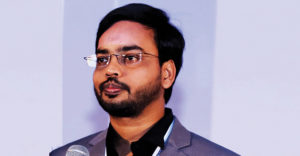
Lajpat Nagar is home to one of the oldest markets in Delhi. It is known for housing the post partition refugee population consisting of Hindus and Sikhs. From being one of the most congested areas to now having a considerably smooth flow of traffic, it has come a long way.
“Lajpat Nagar and Karol Bagh were the pilot projects to possibly bring down the vehicular population. After the implementation of the project, the air quality has improved. We don’t make any profit out of the parking charges we receive. The money we get goes back into the development of the area. We have installed CCTV cameras along the streets. Earlier parking charges were haphazard and mafia used to handle it. Now there is an organised system in place,” said Ashwini Madhwa, Joint Secretary of the Traders Association, Lajpat Nagar.
There are free e-rickshaw facilities from Metro to the market and then there are valet parking facilities. The Market Associations coordinated with the Resident Welfare Associations as the latter had space to accommodate cars inside their compounds.
According to Jha, Lajpat Nagar is able to reinvest the money they get into the development of the area and give around Rs 19 lakh back to MCD.
Despite this, Madhwa points out two major menaces — one being the hawkers and the other is that of autos. Hawkers encroach the footpaths and while the MCD does evacuation drives throughout the day; the hawkers vanish into the by-lanes to hide and re-emerge when the MCD vehicle has gone. Another is the number of rickshaws allegedly operating without licences. “Once you become strict in checking the licenses, half of them will vanish,” claims Madhwa.
Though Madhwa seems to be convinced that the traffic in markets can be regulated and controlled, he has a different opinion about the parking policy charging residential vehicles. “Charging can’t be the solution. You are not guaranteeing any safety to our vehicles but also charging from us. The ideal way to discourage people is to improve the public transport. When DTC introduced AC buses, people reacted by asking why will they pay Rs 20 as compared to cheaper tickets. But now they are running full. So, if you actually improve the facilities, things will change,” he says.
Meanwhile, Pradeep Bansal, Chief Engineer of MCD is busy charting out plans to decongest more markets. It is constant work, he says, as there is not enough space to provide parking space to the ever-increasing surge of vehicles. “We are trying to decongest the markets and next in our plan are Shiva Market in Pitampura as well as markets at Qutub Road, Ghani Maidan and Chandni Chowk. We are planning to introduce eight to ten level parking facilities in Eidgah, Shalimar Bagh, Rani Bagh, Punjabi Bagh, Madhavipur and Udyog Nagar. I am not saying this is sufficient, but we are trying to do whatever we can,” he said.
Is there any solution to the problem?
There are 103 surface parking areas and seven multi-level automated parking areas proposed under South Delhi Municipal Corporation and North Delhi Municipal Corporation. Even as there are many multi-level parking arrangements being planned, everyone is of the same opinion that facilities are nowhere close to the rate at which vehicles are increasing in number.
Dr Satish Chandra, Director of the Central Road Research of India said: “All the people from affluent society park their cars outside their houses to use their parking space within the house for some other purpose like gardening. They are not only encroaching public space occupying footpaths and roads in front of them, but also causing huge delays, congestion and air pollution. This situation is also putting pedestrians at high risk as they tend to conflict with vehicles since they are forced to walk on the road. This lobby has prevented such type of parking policy to be implemented.”
If you have travelled through the road of Kotla, Greater Kailash, you will find hundreds of cars parked on both sides of the roads. There is barely any road left for pedestrians or for moving vehicles.
Sudhir Gupta, a resident of Anand Lok, one of the plush societies in South Delhi, complains that almost every resident owns close to four or five vehicles. One huge mansion at Anand Lok, for instance, had at least five vehicles outside their residence that included a Mercedes and a Porsche.
Gupta himself has two cars. When asked where does he park, he assured that he has enough space within his residential premises.
The parking facilities are distributed in a haphazard manner. Some areas have more than they need and some have none at all. “Some areas, like Hauz Khas, Kalkaji and New Friends Colony have more supply than demand,” said Dr Radha Krishna, Director, Press and information of SDMC.
“The Centre roughly allocates a budget of Rs 200 crore which is not sufficient to make multi- level parking across the cities. Most of the projects take place is private-public partnership mode. Creating multilevel parking can be a costly affair, yet the charges for parking are very less at Rs 10 per hour, and if you are taking a monthly pass it will come to around Rs 2,000,” Jha said.
As Bansal struggles to find viable solutions, he comments, “there is this attitude where an individual think that if I can park my vehicle in front of my house, that too for free, then why should I pay and park? This needs to be changed. Most of DDA’s land allotted for parking goes vacant at night, how do we force people to use the facilities?”
EPCA strongly opposes removing the clause of charging privately owned vehicles. According to them, the already de-congested market is under direct threat as the private vehicles will encroach into the market spaces if they run out of space.
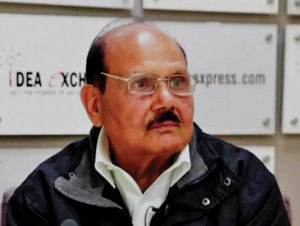
Varsha Joshi, Commissioner, NDMC Sand member of committee set by EPCA agrees to whatever the report suggests, “It is not right for me to comment on this as the matter is sub-judice, but I am in tandem with the EPCA report,” she said, adding, “There is a lack of understanding on this issue but I can’t go around saying this, right? Even now most of us pay in some form for parking in our societies or any other space, this policy will regulate it and bring the vehicles which are not included in this ambit and make them pay.”
Will the implementation of the EPCA suggestions also lead to restricting the number of vehicles owned by an individual as is the case in countries like Singapore? Joshi is convinced this is the only way. “We will be left with no choice but that,” she points out.
Romi Roy, who was associated with UTTIPEC and is now knowledge partner to Ministry of Home Affairs, on the other hand takes a differing stand from Joshi. Roy is okay with the idea of an individual owning as many vehicles as they want till the time they can accommodate it in their compound or if they have enough parking space for it. “I don’t think there should be a restriction on an individual for owning vehicle till he has his own parking space for it,” she said.
Meanwhile, vehicle owners in Delhi have broken out into yet another brawl somewhere in a certain neighbourhood, a phone call has been placed to the police, a scuffle has broken out somewhere and may be someone has been killed over parking space. While life in Delhi is cheap, solutions are expensive — which comes at the cost of intense deliberations and bureaucratic squabbles — and a delay in decision-making in some cases has cost people their lives.

